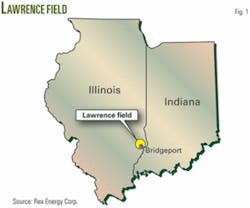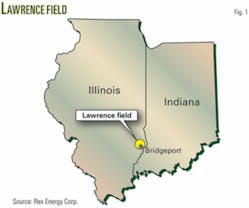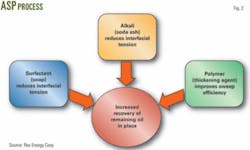One recent announcement on enhanced oil recovery activity is Rex Energy’s plan for starting two alkali-surfactant-polymer (ASP) flood pilots in an old oil field in the Illinois basin.
Benjamin Hulburt, CEO of Rex Energy Corp., State College, Pa., said during a presentation to BMO Capital Markets Corp.’s Fourth Annual Appalachian E&P Forum, Jan. 10, 2008, New York City, that the company plans to start ASP injection in the pilots in early second-quarter 2008.
The pilots will be on 1-acre spacing in Lawrence field, near Bridgeport, Ill. (Fig. 1).
Discovered in 1906, Lawrence field still produces about 1,800 bo/d from 1,000 wells. Hulburt said that initial oil in place in the field, the largest in the Illinois basin, is an estimated 1 billion bbl of which about 400 million bbl has been produced.
ASP process
Hulburt explained that in the ASP process the injectant alkali reduces the needed amount of surfactant to recover the remaining oil in place by interacting with the injected surfactant and rock to form additional surfactant in the reservoir (Fig. 2). The alkali is either sodium hydroxide (NaOH) or soda ash (Na2CO3) and the polymer is a polyacrylamide.
Rex Energy notes that the alkali (1-2%) and surfactant (0.1-0.4%) combination washes residual oil from the reservoir mainly by reducing interfacial tension between the oil and the water. The polymer (800-1,400 ppm) improves sweep displacement efficiency.
The alkali is less costly than surfactant; and therefore, using ASP reduces the injectant costs compared with earlier field pilots that used surfactant and polymer without the alkali. Hulburt said about 90% less surfactant is needed because of the alkali injection.
He said that seven field pilots with surfactant-polymer flooding in sands such as in Lawrence field all had good technical results in the 1960s and 1980s.
In the case of Marathon Oil Corp.’s Robins lease Maraflood surfactant-polymer flood in Lawrence field, about 1 mile from the proposed pilots, the 25-acre pilot recovered 459,000 bbl of incremental oil from 1982 to 1998 (Fig. 3). The production peaked at 370 bo/d in 1988 with the oil cut increasing to 21% up from the 1% oil cut produced prior to the Maraflood.
Although the flood was a technical success, Hulburt said that that the injectant cost $35/incremental bbl recovered during a time when oil prices were in the $10-12/bbl range.
Lawrence field
Hulburt said that Rex Energy owns 13,500 net acres in Lawrence field, which covers most of the field and accounts for about 85% of the total gross production from the field. Marathon operated the field for much of its life before selling it to Plains Illinois Inc.
After Plains divested the field, Rex Energy acquired one quarter of it in 2004 for $3 million, Hulburt said.
Because of its potential for enhanced oil recovery, Hulburt said the company continued to purchase remaining parts of the field at substantially higher costs. The total acquisition cost is now $70 million, Hulburt said.
Rex Energy plans to inject the ASP fluid in two of the major sandstone production horizons in the field: the Mississippian Cypress and the Pennsylvanian Bridgeport sands. Hulburt noted that each sand has had a technically successful surfactant-polymer pilot in the past.
Along with other surfactant pilots in the area, Hulburt said that most of these pilots demonstrated technically successful surfactant-polymer flooding by producing 15-25% of the incremental original oil in place; however, the projects were not economical because the chemical cost per incremental barrel of oil ranged from $10-35. The high cost was because of the large surfactant amounts used, he said.
Rex Energy estimates that ASP flooding in the two sands could recover 84 million bbl of oil. Hulburt said the estimate was based on 16 laboratory-run radial core floods in each sand that showed ASP flooding could recover 20.9% more oil from the Cypress and 24% more oil from the Bridgeport sands.
Because of the small size of the pilots, Hulburt noted that the pilots should respond to the injectant in 3-4 months with peak production occurring in 6-8 months. This compares with the 3½ years that it took the larger 25-acre Marathon pilot to show a response, he said.
Hulburt estimated that the finding and development costs for the project will be $11/bbl with the lifting costs being $3-4/bbl.
For the full field project, Hulburt said Rex Energy plans to develop the flood on 10-acre well spacing in 640 acre increments/year. He expects 12-15 months’ response times for the flooded areas.




